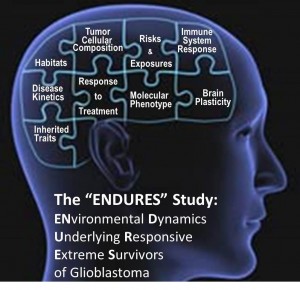The ENDURES Study: Environmental Dynamics Underlying Responsive Extreme Survivors of Glioblastoma
 GBM is considered to be universally fatal, but 5% of patients diagnosed with this disease do survive more than 5 years [1]. Prognostic markers exist but originate from incomplete or static sources and are just pieces of a larger puzzle [2-13]. Current approaches are akin to trying to understand the germination of a seed by looking at its genetic profile but ignoring the impact of the surrounding environment. A more comprehensive approach is needed to understand such complex and integrated systems. To uncover the drivers of extreme survivors (ES) in treatment response and disease progression, we must understand cancer dynamics, the tumor microenvironment, interactions with the rest of the body and the role of the external environment. This project focuses on making dynamic inferences by integrating multiple types of data and creating patient-specific models of tumor growth informed by radiographic and histological analyses. There are clear challenges to this approach since inherited traits and anatomy may create a favorable (or unfavorable) environment for the tumor dynamics to play out. Many unique puzzle pieces must be assembled to create the full picture of extreme survivorship.
GBM is considered to be universally fatal, but 5% of patients diagnosed with this disease do survive more than 5 years [1]. Prognostic markers exist but originate from incomplete or static sources and are just pieces of a larger puzzle [2-13]. Current approaches are akin to trying to understand the germination of a seed by looking at its genetic profile but ignoring the impact of the surrounding environment. A more comprehensive approach is needed to understand such complex and integrated systems. To uncover the drivers of extreme survivors (ES) in treatment response and disease progression, we must understand cancer dynamics, the tumor microenvironment, interactions with the rest of the body and the role of the external environment. This project focuses on making dynamic inferences by integrating multiple types of data and creating patient-specific models of tumor growth informed by radiographic and histological analyses. There are clear challenges to this approach since inherited traits and anatomy may create a favorable (or unfavorable) environment for the tumor dynamics to play out. Many unique puzzle pieces must be assembled to create the full picture of extreme survivorship.
Novel data collection and methods to assimilate information are needed for this project to succeed. To this end, we have brought together the resources of 4 major brain tumor centers and 1 major regional multi-institutional study of gliomas that are perfectly positioned to gather, synthesize and disseminate data regarding extreme GBM survivors. Each institution brings a complementary set of skills, experience and resources to the investigation encompassing imaging, histology, genetics, and patient-reported lifestyle factors to create a large cohort of GBM patients. Thus, we are strategically poised for identifying this complex landscape of factors driving ESs.
Collaborating Institutions
The ENDURES study will be lead by Dr. Kristin Swanson and involve co-primary investigators from Northwestern University, Moffitt Cancer Columbia University, and the University of Washington.
For more information, contact:
Kristin Rae Swanson, PhD
Co-Director, Precision Neurotherapeutics Innovation Lab
Director, Mathematical NeuroOncology Lab
Professor and Vice Chair of Research, Neurosurgery, Mayo Clinic – Phoenix AZ
Professor, Mathematics, Arizona State University – Tempe AZ
Professor, Cancer and Cell Biology, Translational Genomics Institute – Phoenix AZ
Phone: (480) 342-3930
Swanson.Kristin@mayo.edu
5777 E Mayo Blvd, SSB Suite 2-700, Phoenix AZ 85054
MathematicalNeuroOncology.org
References
1. Ostrom, Q.T., et al., CBTRUS statistical report: Primary brain and central nervous system tumors diagnosed in the United States in 2006-2010. Neuro Oncol, 2013. 15 Suppl 2: p. ii1-56.
2. Hartmann, C., et al., Long-term survival in primary glioblastoma with versus without isocitrate dehydrogenase mutations. Clin Cancer Res, 2013. 19(18): p. 5146-57.
3. Field, K.M., et al., Comparison between poor and long-term survivors with glioblastoma: Review of an Australian dataset. Asia Pac J Clin Oncol, 2013.
4. Deb, P., et al., Glioblastoma multiforme with long term survival. Neurol India, 2005. 53(3): p. 329-32.
5. Chaudhry, N.S., et al., Predictors of long-term survival in patients with glioblastoma multiforme: advancements from the last quarter century. Cancer Invest, 2013. 31(5): p. 287-308.
6. Smoll, N.R., K. Schaller, and O.P. Gautschi, Long-term survival of patients with glioblastoma multiforme (GBM). J Clin Neurosci, 2013. 20(5): p. 670-5.
7. Kaur, G., et al., A critical evaluation of cystic features in primary glioblastoma as a prognostic factor for survival. J Neurosurg, 2011. 115(4): p. 754-9.
8. Krex, D., et al., Long-term survival with glioblastoma multiforme. Brain, 2007. 130(Pt 10): p. 2596-606.
9. McLendon, R.E. and E.C. Halperin, Is the long-term survival of patients with intracranial glioblastoma multiforme overstated? Cancer, 2003. 98(8): p. 1745-8.
10. Shinojima, N., et al., The influence of sex and the presence of giant cells on postoperative long-term survival in adult patients with supratentorial glioblastoma multiforme. J Neurosurg, 2004. 101(2): p. 219-26.
11. Lin, C.L., et al., The conditional probabilities of survival in patients with anaplastic astrocytoma or glioblastoma multiforme. Surg Neurol, 2003. 60(5): p. 402-6; discussion 406.
12. Wong, E.T., et al., Outcomes and prognostic factors in recurrent glioma patients enrolled onto phase II clinical trials. J Clin Oncol, 1999. 17(8): p. 2572-8.
13. Scott, J.N., et al., Which glioblastoma multiforme patient will become a long-term survivor? A population-based study. Ann Neurol, 1999. 46(2): p. 183-8.
